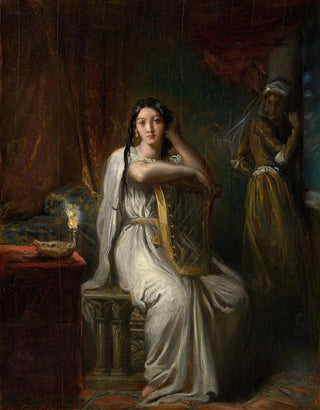Art print | Desdémone Le Chant du Saule - Théodore Chassériau


View from behind

Frame (optional)
Desdémone The Song of the Willow - Théodore Chassériau – Captivating introduction
In the fascinating universe of art, certain works stand out for their ability to transcend time and capture the very essence of human emotion. "Desdémone The Song of the Willow" by Théodore Chassériau is undoubtedly one of these creations. This piece, imbued with melancholy and beauty, evokes a narrative depth that invites the viewer to immerse themselves in a drama that is both personal and universal. The scene, where Desdémone stands at the edge of a willow, evokes a poignant moment of vulnerability, where feelings of loss and hope intertwine. Through this art print, the artist manages to evoke an atmosphere charged with tension and poetry, offering an unforgettable visual experience.
Style and uniqueness of the work
Chassériau's style, marked by his taste for romanticism, is distinguished by a subtle use of color and light. In "Desdémone The Song of the Willow," each brushstroke seems to be a caress, each shade of color an emotion. The chosen palette, oscillating between soft tones and deep shadows, creates a striking contrast that emphasizes the scene's melancholy. The composition, meanwhile, reveals an exceptional mastery of lines and shapes. The willow, a symbol of sadness, appears to envelop Desdémone in a protective embrace, while her delicate expression and posture suggest deep introspection. This painting does not merely depict a moment; it captures a soul in search of redemption and inner peace.
The artist and his influence
Théodore Chassériau, born in 1819, is one of the great masters of French romanticism. Raised in an artistic environment, he was able to absorb influences from his contemporaries while developing a style that is uniquely his own. His fascination with beauty and human tragedy allowed him to create works that still resonate today. Chassériau has often been compared to artists such as Delacroix, but his unique approach, combining sensuality and spirituality, gives him a distinctive place in

Matte finish

View from behind

Frame (optional)
Desdémone The Song of the Willow - Théodore Chassériau – Captivating introduction
In the fascinating universe of art, certain works stand out for their ability to transcend time and capture the very essence of human emotion. "Desdémone The Song of the Willow" by Théodore Chassériau is undoubtedly one of these creations. This piece, imbued with melancholy and beauty, evokes a narrative depth that invites the viewer to immerse themselves in a drama that is both personal and universal. The scene, where Desdémone stands at the edge of a willow, evokes a poignant moment of vulnerability, where feelings of loss and hope intertwine. Through this art print, the artist manages to evoke an atmosphere charged with tension and poetry, offering an unforgettable visual experience.
Style and uniqueness of the work
Chassériau's style, marked by his taste for romanticism, is distinguished by a subtle use of color and light. In "Desdémone The Song of the Willow," each brushstroke seems to be a caress, each shade of color an emotion. The chosen palette, oscillating between soft tones and deep shadows, creates a striking contrast that emphasizes the scene's melancholy. The composition, meanwhile, reveals an exceptional mastery of lines and shapes. The willow, a symbol of sadness, appears to envelop Desdémone in a protective embrace, while her delicate expression and posture suggest deep introspection. This painting does not merely depict a moment; it captures a soul in search of redemption and inner peace.
The artist and his influence
Théodore Chassériau, born in 1819, is one of the great masters of French romanticism. Raised in an artistic environment, he was able to absorb influences from his contemporaries while developing a style that is uniquely his own. His fascination with beauty and human tragedy allowed him to create works that still resonate today. Chassériau has often been compared to artists such as Delacroix, but his unique approach, combining sensuality and spirituality, gives him a distinctive place in






